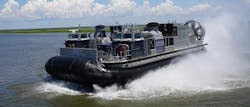Textron to provide next-generation landing craft with rugged embedded computing and navigation systems
Questions and answers:
- What is the purpose of the U.S. Navy’s Ship-to-Shore Connector (SSC) program? It will replace the aging fleet of LCAC vessels with next-generation air cushion craft capable of rapidly transporting Marines and equipment from ships to shore over long distances, with enhanced payload, speed, and reliability.
- What role does L3Harris play in the SSC LCAC vessels? L3Harris provides the advanced data acquisition and control system, which includes integrated cockpit, navigation, and communications to improve vessel performance, maintainability, and operational awareness.
- What are the key capabilities of the SSC LCAC Data Acquisition and Control System? It monitors vessel performance, automates propulsion and navigation controls, and delivers real-time diagnostics and alerts to operators via human-machine interfaces, using rugged embedded computing from North Atlantic Industries.
WASHINGTON – Shipbuilding experts at Textron Systems Corp. will build three more of the U.S. Navy's next-generation landing craft to move Marine Corps infantry and equipment quickly onto invasion beaches from surface warships offshore.
Officials of the Naval Sea Systems Command in Washington announced an $353.9 million order last month to Textron Systems in New Orleans for three Ship-To-Shore Connector (SSC) vessels, which are replacing the Navy's Landing Craft, Air Cushion (LCAC) vessels.
The SSC program is the functional replacement for the existing fleet of LCAC vessels, which are nearing the end of their service life. The SSC program involves air cushion vehicles designed for a 30-year service life.
The SSC mission is to land surface assault elements in support of operational maneuver from the sea, at over-the-horizon distances, while operating from amphibious ships and mobile landing platforms. Textron started building the first SSC LCAC vessels in 2014 as part of a $21.9 million order.
Advanced command and control
SSC electronics feature advanced command, control, communications, and navigation systems that include cockpit equipment and integrated navigational systems for accurate positioning; satellite and inertial navigation; BridgeMaster E surface search radar; AN/ARC-210 UHF/VHF/SATCOM and AN/ARC-220 HF radios; AN/APX-123 identification friend or foe (IFF) transponder; machinery control and power transformers to manage the craft's propulsion onboard power.
The SSC electronics come from L3Harris in partnership with Textron Systems for integrated cockpit and communication technology designed to improve the craft's reliability and maintainability while boosting payload capacity.
SSC provides increased performance to handle current and future missions, as well as improvements which will increase craft availability and reduce total ownership cost, Navy officials say.
The specialized landing craft skims across the surface of the ocean on an air cushion, and can move at speeds faster than 40 knots. The entire hull rides about four feet above the ocean's surface.
Tell me more about the SSC LCAC data acquisition and control system ...
- The SSC LCAC Data Acquisition and Control System monitors platform performance by collecting and processing data from sensors across the vessel; automates control functions by managing propulsion, lift fans, steering, and navigation using digital control algorithms; and provides real-time data visualization, alarms, and diagnostics to the operators through human-machine interfaces (HMIs).
The SSC program will replace the existing fleet of 73 LCAC vessels. SSC LCAC replacement vessels will provide increased performance to handle current and future missions, as well as improvements which will increase craft availability and reduce total ownership cost, Navy officials say. The program will increase the LCAC's payload from 60 to 74 tons.
On the SSC LCAC vessels, L3Harris Integrated Maritime Solutions in Newburyport, Mass., is providing the data acquisition and control system. For the L3Harris data acquisition and control system, North Atlantic Industries (NAI) in Bohemia, N.Y., is providing the SIU35 sensor interface unit embedded computing system.
The NAI SIU35 rugged embedded computing sensor interface unit is an advanced, rugged, and intelligent I/O and communications subsystem for data acquisition and control that provides modularity and distributed interfaces over Ethernet using commercial-off-the-shelf (COTS) products.
Program began in 2012
Textron Systems originally won a potential $570.5 million contract (N00024-12-C-2401) in 2012 to kick off the SSC program by designing and building SSC test and training craft.
Before the SSC program, Navy officials had been upgrading LCAC electronics and other equipment in the The LCAC C4N to replace obsolete equipment on the LCAC, focusing on replacing the vessel's LN-66 radars with modern, high-power P-80 radar systems.
On this contract, Textron will do the work in New Orleans; Pasadena, Calif.; Cincinnati; Gloucester, England; Hunt Valley, Md.; Huntsville, Ala.; Russelville, Ariz.; Stamford, Conn.; West Palm Beach, Fla.; Riverdale, Iowa; Chanhassen, Minn.; Gold Beach, Ore.; and Chesapeake, Va., and should be finished by July 2031.
For more information contact Textron systems online at www.textronsystems.com/products/ship-shore-connector, L3Harris Integrated Maritime Solutions at www.l3harris.com/all-capabilities/integrated-maritime-solutions, North Atlantic Industries at www.naii.com, or Naval Sea Systems Command at www.navsea.navy.mil.
About the Author
John Keller
Editor-in-Chief
John Keller is the Editor-in-Chief, Military & Aerospace Electronics Magazine--provides extensive coverage and analysis of enabling electronics and optoelectronic technologies in military, space and commercial aviation applications. John has been a member of the Military & Aerospace Electronics staff since 1989 and chief editor since 1995.
